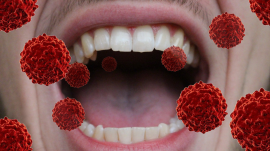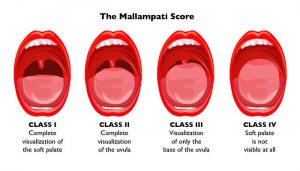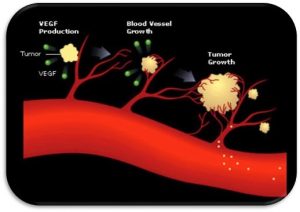
Sleep Apnea and Oral Cancer
As dentists, you perform extra and intra-oral exams of your patient’s mouth, neck, and airway on a regular basis while screening for oral cancer. You understand that these health screenings are important, lifesaving moments in a patient’s health journey– so why not do that with a similarly deadly condition (when untreated) like sleep apnea? Detecting OSA and leading the way for treatment can add YEARS to your patient’s lifespan while significantly improving quality of life.
Both have symptoms that can be easily recognized in the chair during a regular checkup. While checking the mouth for masses and swelling, you can also check on the mallampati score (bellow) and alert your patients to possible concerns you may have. Read more about some common symptoms of sleep apnea that can be detected in the chair here.
The mallampati score chart.
There is also a well-studied connection between sleep apnea and a higher mortality rate for cancer (1). Studies suggest that people suffering from sleep-disordered breathing and the resulting hypoxia have an increased risk of developing cancer and may wind up being up to five times more likely to die from the disease (2). The lack of oxygen caused by OSA can be a catalyst for a process called neovascularization (the creation of new blood vessels), giving a blood supply that can encourage tumor growth.
Symptoms of both oral cancer and sleep apnea should be screened for everyone, especially for heavy drinkers and tobacco users. The irritation from cigarettes and other forms of tobacco may cause inflammation that’s disruptive to the airway. Smoking, of course, is known for its carcinogenic properties, but perhaps more surprising is that around 70% people diagnosed with oral cancer turn out to be heavy drinkers (3). Alcohol use is also known to cause apneic events by relaxing muscles in the airway (this is particularly dangerous when people use alcohol to help get to sleep due to an already existing issue with sleep apnea).
Being able to screen for another life-threatening condition will add an invaluable service to your practice and community. That is why every dentist should learn to screen for OSA and discuss the condition with their patient base.
Sources:
- Campos-Rodriguez, F., Martinez-Garcia, M. A., Martinez, M., Duran-Cantolla, J., De la Pena, M., Masdeu, M. J., . . . Farre, R. (2012, October 29). Association between Obstructive Sleep Apnea and Cancer Incidence in a Large Multicenter Spanish Cohort. Retrieved from atsjorunals. Retrieved November 1, 2019. On behalf of the Spanish Sleep Network
- Nieto, J., Peppard, P. E., Finn, L., Mae Hla, K., & Farré, R. (2012, July 15). Sleep-disordered Breathing and Cancer Mortality. Retrieved November 11, 2018.
- Oral Cancer Risk Factors: Tobacco, Alcohol, others | CTCA. (n.d.). Retrieved October 31, 2018, from cancercenter.com



